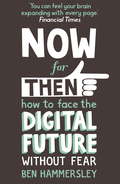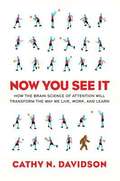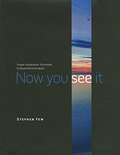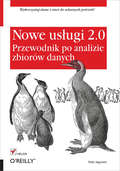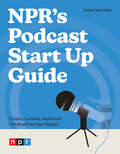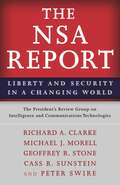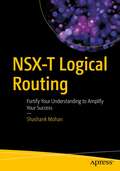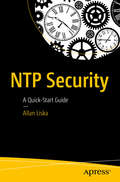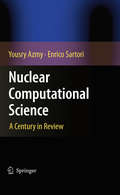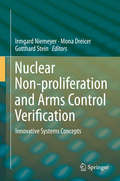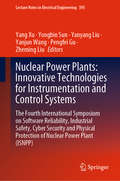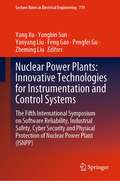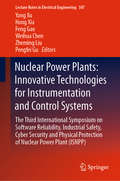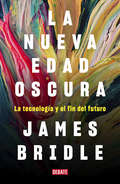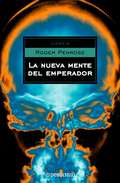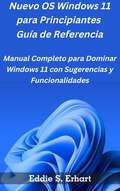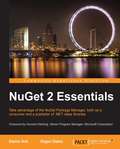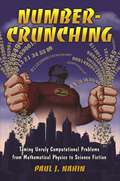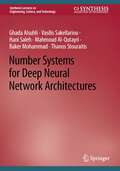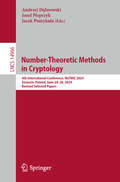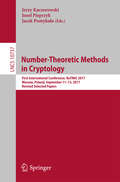- Table View
- List View
Now For Then: How to Face the Digital Future Without Fear
by Ben HammersleyIn 64 THINGS YOU NEED TO KNOW NOW FOR THEN, Editor-at-Large for Wired magazine and guru of the digital age Ben Hammersley gives us the essential guide to the things we need to know for life in the 21st century. Explaining the effects of the changes in the modern world, and the latest ideas in technology, culture, business and politics, this book will demystify the internet, decode cyberspace, and guide you through the innovations of the revolution we are all living through. This is not a book for geeks. 64 THINGS YOU NEED TO KNOW NOW FOR THEN is for everyone who wants to truly understand the modern world, to no longer be confused by the changes in society, business and culture, and to truly prosper in the coming decade.
Now the Chips Are Down: The BBC Micro
by Alison GazzardIn 1982, the British Broadcasting Corporation launched its Computer Literacy Project, intended "to introduce interested adults to the world of computers and computing." The BBC accompanied this initiative with television programs, courses, books, and software -- an early experiment in multi-platform education. The BBC, along with Acorn Computers, also introduced the BBC Microcomputer, which would be at the forefront of the campaign. The BBC Micro was designed to meet the needs of users in homes and schools, to demystify computing, and to counter the general pessimism among the media in Britain about technology. In this book, Alison Gazzard looks at the BBC Micro, examining the early capabilities of multi-platform content generation and consumption and the multiple literacies this approach enabled -- not only in programming and software creation, but also in accessing information across a range of media, and in "do-it-yourself" computing. She links many of these early developments to current new-media practices. Gazzard looks at games developed for the BBC Micro, including Granny's Garden, an educational game for primary schools, and Elite, the seminal space-trading game. She considers the shift in focus from hardware to peripherals, describing the Teletext Adapter as an early model for software distribution and the Domesday Project (which combined texts, video, and still photographs) as a hypermedia-like experience. Gazzard's account shows the BBC Micro not only as a vehicle for various literacies but also as a user-oriented machine that pushed the boundaries of what could be achieved in order to produce something completely new.
Now the Chips Are Down: The BBC Micro (Platform Studies)
by Alison GazzardThe story of a pioneering microcomputer: its beginnings as part of a national Computer Literary Project, its innovative hardware, and its creative uses.In 1982, the British Broadcasting Corporation launched its Computer Literacy Project, intended “to introduce interested adults to the world of computers and computing.” The BBC accompanied this initiative with television programs, courses, books, and software—an early experiment in multi-platform education. The BBC, along with Acorn Computers, also introduced the BBC Microcomputer, which would be at the forefront of the campaign. The BBC Micro was designed to meet the needs of users in homes and schools, to demystify computing, and to counter the general pessimism among the media in Britain about technology. In this book, Alison Gazzard looks at the BBC Micro, examining the early capabilities of multi-platform content generation and consumption and the multiple literacies this approach enabled—not only in programming and software creation, but also in accessing information across a range of media, and in “do-it-yourself” computing. She links many of these early developments to current new-media practices.Gazzard looks at games developed for the BBC Micro, including Granny's Garden, an educational game for primary schools, and Elite, the seminal space-trading game. She considers the shift in focus from hardware to peripherals, describing the Teletext Adapter as an early model for software distribution and the Domesday Project (which combined texts, video, and still photographs) as a hypermedia-like experience. Gazzard's account shows the BBC Micro not only as a vehicle for various literacies but also as a user-oriented machine that pushed the boundaries of what could be achieved in order to produce something completely new.
Now You See It
by Davidson Cathy N.When Cathy Davidson and Duke University gave free iPods to every member of the incoming freshman class in 2003, they didn't expect the uproar that followed. Critics called it a waste: What educational value could a music player have for college kids? Yet by the end of the year, Duke students had found academic uses for the new devices in virtually every discipline. The iPod experiment proved to be a classic example of the power of disruption -- a way of refocusing attention to illuminate unseen possibilities. Using cutting-edge research on the brain, Davidson shows how the phenomenon of "attention blindness" shapes our lives, and how it has led to one of the greatest problems of our historical moment: Although we blog, tweet, and text as if by instinct, far too many of us still toil in schools and workplaces designed for the last century, not the one we live in. To change this, we must ask ourselves critical questions: How can we redesign our schools to prepare our kids for the challenges they'll face as adults? What will the workers and workplaces of the future look like? And how can we learn to adapt to life changes that seem almost too revolutionary to contemplate?Davidson takes us on a tour of the future of work and education, introducing us to visionaries whose groundbreaking ideas will soon affect us all. Now You See It opens a window onto the possibilities of a world in which the rigid ideas of the twentieth century have been wiped away and replaced with the flowing, collaborative spirit built into the very design of the Internet.
Now you see it: Simple Visualization Techniques for Quantitative Analysis
by Stephen FewThis book features graphical techniques that can be applied to a broad range of software tools, including Microsoft Excel, because so many people have nothing else, but also more powerful visual analysis tools that can dramatically extend your analytical reach. You'll learn to make sense of quantitative data by discerning the meaningful patterns, trends, relationships, and exceptions that measure your organization's performance, identify potential problems and opportunities, and reveal what will likely happen in the future.
Nowe us?ugi 2.0. Przewodnik po analizie zbiorów danych
by Toby SegaranWykorzystaj dane z sieci do w?asnych potrzeb!Internet to nic innego jak gigantyczny zbiór danych. Ka?dy, kto znajdzie sposób na ich umiej?tne wykorzystanie, ma szans? zbudowa? aplikacj?, która odniesie ?wiatowy sukces. Serwisy randkowe, portale spo?eczno?ciowe, porównywarki cen — to tylko drobna cz??? serwisów, które mo?esz wykorzysta? przy tworzeniu nowej us?ugi. Jak analizowa? dane i wyci?gn?? wnioski? Na wiele podobnych pyta? odpowiada ta jedyna w swoim rodzaju ksi??ka.W trakcie lektury poznasz najlepsze sposoby filtrowania danych, tworzenia rekomendacji, wykrywania grup oraz wyszukiwania i klasyfikowania. Na kolejnych stronach znajdziesz bogaty zbiór informacji po?wi?conych algorytmom analizuj?cym dane. Ponadto b?dziesz mie? mo?liwo?? zapoznania si? z ró?nymi sposobami optymalizacji, modelowania przy u?yciu drzew decyzyjnych oraz tworzenia modeli cenowych. Ksi??ka ta w r?kach wprawnego programisty mo?e stanowi? niesamowite narz?dzie. Otwiera wrota do ?wiata pe?nego danych i zale?no?ci pomi?dzy nimi!Dzi?ki tej ksi??ce: poznasz najlepsze i najskuteczniejsze algorytmy do analizy danych zbudujesz model cen nauczysz si? korzysta? z drzew decyzyjnych zastosujesz dane z sieci do budowy nowych us?ugWyci?gnij w?a?ciwe wnioski z posiadanych danych!
NPR's Podcast Start Up Guide: Create, Launch, and Grow a Podcast on Any Budget
by Glen WeldonFrom NPR comes the definitive guide to podcasting—featuring step-by-step advice on how to find a unique topic, tell the best stories, and engage the most listeners, as well as the secrets that will take your pod to the next level.Whoever you are, whatever you love, there&’s a podcast audience waiting for you, and in today&’s booming audio storytelling landscape, it&’s never been easier to share your voice with the world. But while the barrier to entry for podcast production is relatively low (just the cost of a mic and a laptop), the learning curve is steep—and quality matters. That&’s where NPR comes in. In NPR&’s Podcast Start Up Guide, Glen Weldon draws on NPR&’s extensive educational materials and army of talent—from recognizable hosts, such as Guy Raz (How I Built This), Gene Demby (Code Switch), Linda Holmes (Pop Culture Happy Hour), and Yowei Shaw (Invisibilia), to indispensable behind-the-scenes players, such as producers, engineers, and editors—to guide aspiring podcasters through the conception, creation, and launch of a podcast. Part master class, part candid informational interview with the best in the business, this book is a must-read for anyone who wants to make their dream of starting a podcast a reality.
The NSA Report: Liberty and Security in a Changing World
by President's Review Group on Intelligence and Communications Technologies, The Richard A. Clarke Michael J. Morell Geoffrey R. Stone Cass R. Sunstein Peter SwireThe official report that has shaped the international debate about NSA surveillance"We cannot discount the risk, in light of the lessons of our own history, that at some point in the future, high-level government officials will decide that this massive database of extraordinarily sensitive private information is there for the plucking. Americans must never make the mistake of wholly 'trusting' our public officials."—The NSA ReportThis is the official report that is helping shape the international debate about the unprecedented surveillance activities of the National Security Agency. Commissioned by President Obama following disclosures by former NSA contractor Edward J. Snowden, and written by a preeminent group of intelligence and legal experts, the report examines the extent of NSA programs and calls for dozens of urgent and practical reforms. The result is a blueprint showing how the government can reaffirm its commitment to privacy and civil liberties—without compromising national security.
NSX-T Logical Routing: Fortify Your Understanding to Amplify Your Success
by Shashank MohanThis book is a one-stop guide for IT professionals with a background in traditional and software-defined networks looking to expand or hone their skill set and has been developed through a combination of extensive research and testing in both development and production environments. It provides reliable information on a fundamental component of NSX-T, logical routing.A comprehensive understanding of this capability will help IT professionals with design, implementation, troubleshooting, and enhancements.The book starts with an introduction to the foundational components of the NSX-T platform and how NSX-T fits into the software-defined data center. The focus then moves to tunnel endpoints, which is a critical aspect of the NSX-T platform, and the differences between overlays and underlays are explained. Once the basics are covered, it provides a detailed description of how NSX-T components communicate.Next, the book introduces logical routing and its components and provides a better understanding of how these components function with one another. Several packet walks are illustrated to explain NSX-T logical routing behavior in different scenarios. After mastering logical routing, it explains how NSX-T ensures data plane availability, which is explored at various layers of NSX-T.Finally, the book explores the concepts and intricacies of routing into and out of the NSX-T environment. It deep dives into utilizing the Border Gateway Protocol (BGP), Open Shortest Path First (OSPF), and Static Routing.What You Will LearnKnow how VMware NSX-T endpoints communicate Understand how NSX-T logical routing works Know how NSX-T provides high availability for the data plane Understand how NSX-T operates with static and dynamic routing protocolsConfigure the platform Who This Book Is ForReaders with an intermediate to advanced skill set who wish to further their knowledge, those who focus on datacenter technology, those planning to move to a software-defined datacenter to transform the way their current datacenter works, and anyone looking to learn about VMware NSX-T and how it operates
NTP Security
by Allan LiskaLearn the risks associated with Network Time Protocol (NTP) security and how to minimize those risks while deploying and managing the protocol. You will be able to reduce the disruption of communication between servers on the network and the risk that the entire network will be taken offline. NTP Security: A Quick-Start Guide provides an understanding of how NTP is critical to modern networks and how it can be exploited. You will understand how an attacker can wreak havoc on an insecure network and guidance is provided to help you manage your system and make it more secure. What You Will Learn: Understand the vulnerabilities, flaws, and risks associated with the Network Time protocol (NTP) Analyze NTP traffic and configure NTP on servers and workstations in the network in a more secure manner Use practical solutions to secure NTP and build a robust infrastructure, such as bringing more capability inside the network and creating a smaller attack surface Determine the alternatives to NTP, including how to synchronize network clocks in other ways Who This Book Is For: System administrators, network engineers, and security analysts
Nuclear Computational Science
by Yousry Azmy Enrico SartoriNuclear engineering has undergone extensive progress over the years. In the past century, colossal developments have been made and with specific reference to the mathematical theory and computational science underlying this discipline, advances in areas such as high-order discretization methods, Krylov Methods and Iteration Acceleration have steadily grown. Nuclear Computational Science: A Century in Review addresses these topics and many more; topics which hold special ties to the first half of the century, and topics focused around the unique combination of nuclear engineering, computational science and mathematical theory. Comprising eight chapters, Nuclear Computational Science: A Century in Review incorporates a number of carefully selected issues representing a variety of problems, providing the reader with a wealth of information in both a clear and concise manner. The comprehensive nature of the coverage and the stature of the contributing authors combine to make this a unique landmark publication. Targeting the medium to advanced level academic, this book will appeal to researchers and students with an interest in the progression of mathematical theory and its application to nuclear computational science.
Nuclear Non-proliferation and Arms Control Verification: Innovative Systems Concepts
by Irmgard Niemeyer Mona Dreicer Gotthard SteinThis book strives to take stock of current achievements and existing challenges in nuclear verification, identify the available information and gaps that can act as drivers for exploring new approaches to verification strategies and technologies. With the practical application of the systems concept to nuclear disarmament scenarios and other, non-nuclear verification fields, it investigates, where greater transparency and confidence could be achieved in pursuit of new national or international nonproliferation and arms reduction efforts. A final discussion looks at how, in the absence of formal government-to-government negotiations, experts can take practical steps to advance the technical development of these concepts.
Nuclear Power Plants: The Fourth International Symposium on Software Reliability, Industrial Safety, Cyber Security and Physical Protection of Nuclear Power Plant (ISNPP) (Lecture Notes in Electrical Engineering #595)
by Yanjun Wang Yang Xu Zheming Liu Pengfei Gu Yongbin Sun Yanyang LiuThis book presents a compilation of selected papers from the Fourth International Symposium on Software Reliability, Industrial Safety, Cyber Security and Physical Protection of Nuclear Power Plant, held in August 2019 in Guiyang, China. The purpose of the symposium was to discuss inspection, testing, certification and research concerning the software and hardware of instrument and control (I&C) systems used at nuclear power plants (NPP), such as sensors, actuators and control systems. The event provides a venue for exchange among experts, scholars and nuclear power practitioners, as well as a platform for the combination of teaching and research at universities and enterprises to promote the safe development of nuclear power plants. Readers will find a wealth of valuable insights into achieving safer and more efficient instrumentation and control systems.
Nuclear Power Plants: The Fifth International Symposium on Software Reliability, Industrial Safety, Cyber Security and Physical Protection of Nuclear Power Plant (ISNPP) (Lecture Notes in Electrical Engineering #779)
by Yang Xu Yongbin Sun Yanyang Liu Feng Gao Pengfei Gu Zheming LiuThis book is a compilation of selected papers from the fifth International Symposium on Software Reliability, Industrial Safety, Cyber Security and Physical Protection of Nuclear Power Plant, held in November 2020 in Beijing, China. The purpose of this symposium is to discuss Inspection, test, certification and research for the software and hardware of Instrument and Control (I&C) systems in nuclear power plants (NPP), such as sensors, actuators and control system. It aims to provide a platform of technical exchange and experience sharing for those broad masses of experts and scholars and nuclear power practitioners, and for the combination of production, teaching and research in universities and enterprises to promote the safe development of nuclear power plant. Readers will find a wealth of valuable insights into achieving safer and more efficient instrumentation and control systems.
Nuclear Power Plants: The Sixth International Symposium on Software Reliability, Industrial Safety, Cyber Security and Physical Protection of Nuclear Power Plant (ISNPP) (Lecture Notes in Electrical Engineering #883)
by Yang Xu Yongbin Sun Yanyang Liu Feng Gao Pengfei Gu Zheming LiuThis book is a compilation of selected papers from the Sixth International Symposium on Software Reliability, Industrial Safety, Cyber Security and Physical Protection of Nuclear Power Plant, held in October 2021 in Zhuji, Zhejiang, China. The purpose of this symposium is to discuss Inspection, test, certification and research for the software and hardware of Instrument and Control (I&C) systems in nuclear power plants (NPP), such as sensors, actuators and control system. It aims to provide a platform of technical exchange and experience sharing for those broad masses of experts and scholars and nuclear power practitioners, and for the combination of production, teaching and research in universities and enterprises to promote the safe development of nuclear power plant. Readers will find a wealth of valuable insights into achieving safer and more efficient instrumentation and control systems.
Nuclear Power Plants: The Third International Symposium on Software Reliability, Industrial Safety, Cyber Security and Physical Protection of Nuclear Power Plant (ISNPP) (Lecture Notes in Electrical Engineering #507)
by Yang Xu Hong Xia Feng Gao Weihua Chen Zheming Liu Pengfei GuThis book is a compilation of selected papers from the 3rd International Symposium on Software Reliability, Industrial Safety, Cyber Security and Physical Protection of Nuclear Power Plants, held in Harbin, China on 15th–17th August 2018. The symposium discussed the status quo, technical advances and development direction of digital instrument control technology, software reliability, information security and physical protection in the process of nuclear power development. Offering technical insights and know from leading experts, this book is a valuable resource for both practitioners and academics working in the field of nuclear instrumentation, control systems and other safety-critical systems, as well as nuclear power plant managers, public officials, and regulatory authorities.
La nueva edad oscura: La tecnología y el fin del futuro
by James BridleEntre tanto dato no contrastado, posverdad y fake news, este libro nos alerta y nos empuja a vislumbrar la verdad en esta nueva edad oscura de la información. Cuanto más aumenta la complejidad del mundo tecnológico, más disminuye nuestra comprensión de la realidad: la información que recibimos a diario está plagada de datos no contrastados, de posverdad, de teorías conspirativas... Todo esto nos convierte, cada vez más, en náufragos perdidos en un mar de especulación. James Bridle, el mediático tecnólogo y autor de estas páginas, nos advierte ante un futuro en el que la promesa contemporánea de un conocimiento brindado por la tecnología puede traernos justo lo contrario: una era de incertidumbre, algoritmos predictivos y minuciosos sistemas de vigilancia. Un libro magistral y aterrador que nos adentra en la inquietante tormenta que acecha el debate de las maravillas del mundo digital. Reseñas:«Espero los lectores no disfruten esta perceptiva y sugerente obra, sino que, más bien, sientan pavor.»Will Self, The Guardian «Bridle es un artista y escritor que debate sobre la relación entre tecnología, cultura y conciencia y cuya fama aumenta por momentos. Entre los temas alrededor de los cuales gira su arte están los drones y los coches automatizados. Su nuevo y ambicioso libro presenta cómo la era digital está modificando radicalmente los paradigmas de la experiencia humana.»The Guardian «La obra revela la forma en la que se nos tiene deliberadamente desinformados y cómo estamos adentrándonos de manera inconsciente en un futuro de vigilancia ininterrumpida que nubla nuestros sueños sobre las maravillas del mundo digital.»Financial Times «Un Orwell en la era de la tecnología.»Kirkus Reviews «James Bridle demuestraser un maestro a la hora de encontrar contradicciones en las tecnologías actuales. Este es un libro de extrema importancia en estos tiempos.»Bernard Hay, The Quietus «Un alarmante grito de guerra. El autor es extremadamente convincente al abogar por una interacción más informada con las tecnologías que hemos creado.»Ben Eastham, ArtReview «Una perspectiva firme y una provocación necesaria. Horroroso pero fascinante.»Jamie Bartlett, Spectator «Un libro tan original como provocador.»Pat Kane, New Scientist «Mi ejemplar de este libro está repleto de notas que se amontonan en los márgenes. Me siento como un estudiante de química orgánica que, abrumado, siente la necesidad de subrayarlo absolutamente todo: todo es importante y está conectado y, al mismo tiempo, el autor describe intencionadamente un mundo sin sentido. Denso, absorbente y convincente a más no poder.»Barbara Fister, Inside Higher Education«Este es uno de los libros más perturbadores y reveladores sobre Internet que he leído jamás, lo cual viene a ser lo mismo que decir que es uno de los libros más perturbadores y reveladores que he leído sobre el mundo contemporáneo.»New Yorker «Una tenebrosa puerta que se abre a una nueva era. Una obra escalofriante sobre la oscuridad del mundo digital y los peligros más imprevisibles e imparables que hemos traído al mundo desde el Proyecto Manhattan.»Vice
La nueva mente del emperador: En Torno A La Cibernética, La Mente Y Las Leyes De La Física (Ciencia Y Tecnología Ser.)
by Roger PenroseUn apasionante paseo por la matemática y la física, y por los hallazgos del pensamiento humano. Durante décadas, los defensores de la inteligencia artificial han mantenido que los ordenadores harán pronto todo lo que la mente humana puede hacer. En su favor, se puede utilizar, por ejemplo, el que ya hay máquinas que juegan al ajedrez como los grandes maestros. Ahora bien, ¿comprenden el juego como lo hacemos nosotros? En este libro, Roger Penrose, probablemente el especialista en la teoría general de la relatividad más prestigioso del mundo y una de las mentes analíticas más originales de la actualidad, sostiene que existen facetas del pensamiento humano que nunca serán emuladas por un ordenador. Para defender esa tesis, Penrose recurre a una amplia gama de conocimientos científicos, que van desde la máquina de Turing hasta la estructura del cerebro, pasando por el teorema de Gödel, los agujeros negros y los blancos, la radiación de Hawking, la entropía o la mecánica cuántica. Entre los numerosos estudios existentes dedicados a la relación entre la mente y el cuerpo, esta ambiciosa obra sobresale tanto por su lucidez y claridad como por su rigor y profundidad. Reseña:«Un libro audaz, brillante e innovador. Cuando Penrose habla, los científicos escuchan.»The New York Times Book Review
Nuevo OS Windows 11 para Principiantes Guía de Referencia: Manual Completo para Dominar Windows 11 con Sugerencias y Funcionalidades
by Eddie E. ErhartCon la última iteración en la larga lista de sistemas operativos de Microsoft llega el Windows 11, que es sin duda el paquete completo de todo lo que siempre quiso en un sistema operativo para PC. Con este fantástico software ya en el mercado, no es de extrañar que quiera hacerse con una copia y dominarlo en el menor tiempo posible. La Guía de referencia para principiantes del nuevo sistema operativo Windows 11 le proporciona información valiosa respaldada por explicaciones bien detalladas, todo ello con el fin de asegurarse de que se pone manos a la obra. Este viaje comienza con una introducción a las características que hacen único a Windows 11, y luego nos adentramos en la sala de máquinas de lo que hace funcionar al nuevo sistema operativo. A lo largo de este viaje, se le presentará lo siguiente: Nuevas características de Windows 11 Descarga e instalación de Windows 11 Cómo navegar por Windows 11 Cómo localizar sus archivos Configurar varias cuentas Personalizar los widgets Personalización de temas y fuentes Cómo utilizar Microsoft Teams Conectarse a una red Wi-Fi Mejorar la productividad del Explorador de archivos Crear particiones en Windows 11 Activar la configuración de privacidad La sinergia entre Windows 11 y el sistema operativo Android Y mucho más.
NuGet 2 Essentials
by Dejan Dakic Damir ArhThis concise guide is full of hands-on examples to guide you through all of NuGet's features and use them in everyday development of .NET frameworks.If you are a .NET developer who wants to learn more about NuGet, this book is ideal for you. Although it doesn't require any prior knowledge about NuGet itself, it assumes that you are already familiar with Visual Studio and the .NET framework. All code in the examples is written using C# so you will also need at least a basic knowledge of the language.
Number-Crunching: Taming Unruly Computational Problems from Mathematical Physics to Science Fiction
by Paul J. NahinMore stimulating mathematics puzzles from bestselling author Paul NahinHow do technicians repair broken communications cables at the bottom of the ocean without actually seeing them? What's the likelihood of plucking a needle out of a haystack the size of the Earth? And is it possible to use computers to create a universal library of everything ever written or every photo ever taken? These are just some of the intriguing questions that best-selling popular math writer Paul Nahin tackles in Number-Crunching. Through brilliant math ideas and entertaining stories, Nahin demonstrates how odd and unusual math problems can be solved by bringing together basic physics ideas and today's powerful computers. Some of the outcomes discussed are so counterintuitive they will leave readers astonished.Nahin looks at how the art of number-crunching has changed since the advent of computers, and how high-speed technology helps to solve fascinating conundrums such as the three-body, Monte Carlo, leapfrog, and gambler's ruin problems. Along the way, Nahin traverses topics that include algebra, trigonometry, geometry, calculus, number theory, differential equations, Fourier series, electronics, and computers in science fiction. He gives historical background for the problems presented, offers many examples and numerous challenges, supplies MATLAB codes for all the theories discussed, and includes detailed and complete solutions.Exploring the intimate relationship between mathematics, physics, and the tremendous power of modern computers, Number-Crunching will appeal to anyone interested in understanding how these three important fields join forces to solve today's thorniest puzzles.
Number Systems for Deep Neural Network Architectures (Synthesis Lectures on Engineering, Science, and Technology)
by Ghada Alsuhli Vasilis Sakellariou Hani Saleh Mahmoud Al-Qutayri Baker Mohammad Thanos StouraitisThis book provides readers a comprehensive introduction to alternative number systems for more efficient representations of Deep Neural Network (DNN) data. Various number systems (conventional/unconventional) exploited for DNNs are discussed, including Floating Point (FP), Fixed Point (FXP), Logarithmic Number System (LNS), Residue Number System (RNS), Block Floating Point Number System (BFP), Dynamic Fixed-Point Number System (DFXP) and Posit Number System (PNS). The authors explore the impact of these number systems on the performance and hardware design of DNNs, highlighting the challenges associated with each number system and various solutions that are proposed for addressing them.
Number-Theoretic Methods in Cryptology: 4th International Conference, NuTMiC 2024, Szczecin, Poland, June 24–26, 2024, Revised Selected Papers (Lecture Notes in Computer Science #14966)
by Andrzej Dąbrowski Josef Pieprzyk Jacek PomykałaThis book constitutes the refereed post-conference proceedings of the 4th International Conference on Number-Theoretic Methods in Cryptology, NuTMiC 2024, held in Szczecin, Poland, during June 24–26, 2024.The 9 full papers and 2 invited papers presented in this book were carefully reviewed and selected from 12 submissions. They were organized in topical sections as follows: invited talks; elliptic curves in cryptography; number theory; algebraic structures and public-key cryptography.
Number-Theoretic Methods in Cryptology: First International Conference, Nutmic 2017, Warsaw, Poland, September 11-13, 2017, Revised Selected Papers (Lecture Notes in Computer Science #10737)
by Jerzy Kaczorowski Josef Pieprzyk Jacek PomykałaThis book constitutes the refereed post-conference proceedings of the First International Conference on Number-Theoretic Methods in Cryptology, NuTMiC 2017, held in Warsaw, Poland, in September 2017.The 15 revised full papers presented in this book together with 3 invited talks were carefully reviewed and selected from 32 initial submissions. The papers are organized in topical sections on elliptic curves in cryptography; public-key cryptography; lattices in cryptography; number theory; pseudorandomness; and algebraic structures and analysis.
Number Theory Meets Wireless Communications (Mathematical Engineering)
by Victor Beresnevich Alister Burr Bobak Nazer Sanju VelaniThis volume explores the rich interplay between number theory and wireless communications, reviewing the surprisingly deep connections between these fields and presenting new research directions to inspire future research. The contributions of this volume stem from the Workshop on Interactions between Number Theory and Wireless Communication held at the University of York in 2016. The chapters, written by leading experts in their respective fields, provide direct overviews of highly exciting current research developments. The topics discussed include metric Diophantine approximation, geometry of numbers, homogeneous dynamics, algebraic lattices and codes, network and channel coding, and interference alignment. The book is edited by experts working in number theory and communication theory. It thus provides unique insight into key concepts, cutting-edge results, and modern techniques that play an essential role in contemporary research. Great effort has been made to present the material in a manner that is accessible to new researchers, including PhD students. The book will also be essential reading for established researchers working in number theory or wireless communications looking to broaden their outlook and contribute to this emerging interdisciplinary area.
